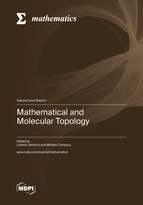Mathematical and Molecular Topology
A special issue of Mathematics (ISSN 2227-7390). This special issue belongs to the section "Algebra, Geometry and Topology".
Deadline for manuscript submissions: closed (31 January 2023) | Viewed by 13190
Special Issue Editors
Interests: applied mathematics; applied informatics
Special Issues, Collections and Topics in MDPI journals
Special Issue Information
Dear Colleagues,
This Special Issue, "Mathematical and Molecular Topology", is open for submissions and welcomes papers from a broad interdisciplinary area, since topology is concerned with the properties of objects that are preserved under continuous deformations, such as stretching, twisting, crumpling and bending. One of the oldest problems in topology is The Seven Bridges of Königsberg.
Topology naturally finds application in all fields of engineering, physical sciences, life sciences, social sciences, medicine, business and even arts. The motivating insight behind topology is that some geometric problems depend not on the exact shape of the objects involved, but rather on the way they are put together.
In about 1750, Euler stated the polyhedron formula, V − E + F = 2 (where V, E, and F respectively indicate the number of vertices, edges, and faces of the polyhedron), which may be regarded as the first theorem, signaling the birth of topology.
Subjects included in topology are graph theory and algebraic topology. MSC 2010 subjects related to topology include the following: Number theory (with Density, gaps, topology and Relations with algebraic geometry and topology); Algebraic geometry (with Topology of surfaces—Donaldson polynomials, Seiberg–Witten invariants and Topology of real algebraic varieties); Category theory & homological algebra (for categories in topology); K-theory (for obstructions from topology); Group theory and generalizations (for other groups related to topology); Topological groups & Lie groups; Real functions (for elementary topology of the line); Several complex variables and analytic spaces (for Topology of analytic spaces); Dynamical systems and ergodic theory (for Topology in relation with holomorphic dynamical systems and Relations of infinite-dimensional Hamiltonian and Lagrangian dynamical systems with topology); Functional analysis (for Embeddings of discrete metric spaces into Banach spaces; applications in topology, Hilbert and pre-Hilbert spaces: geometry and topology, Noncommutative topology, and Methods of algebraic topology in functional analysis); Quantum theory (for Feynman integrals and graphs; applications of algebraic topology); Game theory, economics, finance, and other social and behavioral sciences (for Games involving topology); and finally Biology and other natural sciences (for Molecular structure—graph-theoretic methods, methods of differential topology and alike). Finally, three sections of MSC are almost entirely devoted to or build upon topology: General topology (54-XX), Algebraic topology (55-XX) and Manifolds and cell complexes (57-XX).
Prof. Dr. Lorentz Jäntschi
Dr. Mihaela Tomescu
Guest Editors
Manuscript Submission Information
Manuscripts should be submitted online at www.mdpi.com by registering and logging in to this website. Once you are registered, click here to go to the submission form. Manuscripts can be submitted until the deadline. All submissions that pass pre-check are peer-reviewed. Accepted papers will be published continuously in the journal (as soon as accepted) and will be listed together on the special issue website. Research articles, review articles as well as short communications are invited. For planned papers, a title and short abstract (about 100 words) can be sent to the Editorial Office for announcement on this website.
Submitted manuscripts should not have been published previously, nor be under consideration for publication elsewhere (except conference proceedings papers). All manuscripts are thoroughly refereed through a single-blind peer-review process. A guide for authors and other relevant information for submission of manuscripts is available on the Instructions for Authors page. Mathematics is an international peer-reviewed open access semimonthly journal published by MDPI.
Please visit the Instructions for Authors page before submitting a manuscript. The Article Processing Charge (APC) for publication in this open access journal is 2600 CHF (Swiss Francs). Submitted papers should be well formatted and use good English. Authors may use MDPI's English editing service prior to publication or during author revisions.
Keywords
- algebraic topology
- clopen sets
- cohomology
- compactness
- connectedness
- continuity
- differential topology
- euclidean spaces
- geometric topology
- graph theory
- grothendieck topologies
- homeomorphisms
- homology
- homotopy
- manifolds
- metric spaces
- molecular topology
- point-set topology
- surgery theory
- topological invariants







